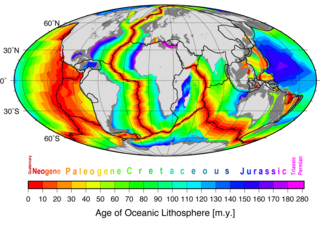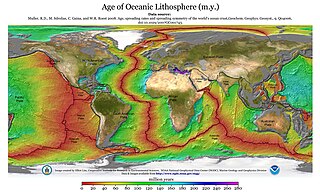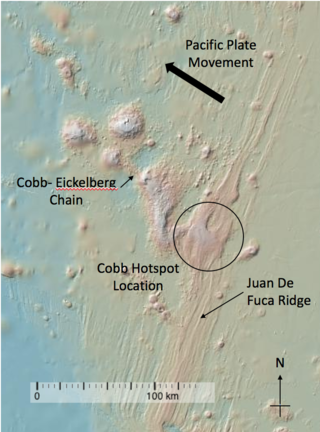Related Research Articles

Plate tectonics is the scientific theory that Earth's lithosphere comprises a number of large tectonic plates which have been slowly moving since about 3.4 billion years ago. The model builds on the concept of continental drift, an idea developed during the first decades of the 20th century. Plate tectonics came to be accepted by geoscientists after seafloor spreading was validated in the mid-to-late 1960s.

Seafloor spreading or Seafloor spread is a process that occurs at mid-ocean ridges, where new oceanic crust is formed through volcanic activity and then gradually moves away from the ridge.

Oceanic crust is the uppermost layer of the oceanic portion of the tectonic plates. It is composed of the upper oceanic crust, with pillow lavas and a dike complex, and the lower oceanic crust, composed of troctolite, gabbro and ultramafic cumulates. The crust overlies the rigid uppermost layer of the mantle. The crust and the rigid upper mantle layer together constitute oceanic lithosphere.

Marine geology or geological oceanography is the study of the history and structure of the ocean floor. It involves geophysical, geochemical, sedimentological and paleontological investigations of the ocean floor and coastal zone. Marine geology has strong ties to geophysics and to physical oceanography.

A mid-ocean ridge (MOR) is a seafloor mountain system formed by plate tectonics. It typically has a depth of about 2,600 meters (8,500 ft) and rises about 2,000 meters (6,600 ft) above the deepest portion of an ocean basin. This feature is where seafloor spreading takes place along a divergent plate boundary. The rate of seafloor spreading determines the morphology of the crest of the mid-ocean ridge and its width in an ocean basin.
The Lamont–Doherty Earth Observatory (LDEO) is the scientific research center of the Columbia Climate School, and a unit of The Earth Institute at Columbia University. It focuses on climate and earth sciences and is located on a 189-acre campus in Palisades, New York, 18 miles (29 km) north of Manhattan on the Hudson River.

A back-arc basin is a type of geologic basin, found at some convergent plate boundaries. Presently all back-arc basins are submarine features associated with island arcs and subduction zones, with many found in the western Pacific Ocean. Most of them result from tensional forces, caused by a process known as oceanic trench rollback, where a subduction zone moves towards the subducting plate. Back-arc basins were initially an unexpected phenomenon in plate tectonics, as convergent boundaries were expected to universally be zones of compression. However, in 1970, Dan Karig published a model of back-arc basins consistent with plate tectonics.

A sheeted dyke complex, or sheeted dike complex, is a series of sub-parallel intrusions of igneous rock, forming a layer within the oceanic crust. At mid-ocean ridges, dykes are formed when magma beneath areas of tectonic plate divergence travels through a fracture in the earlier formed oceanic crust, feeding the lavas above and cooling below the seafloor forming upright columns of igneous rock. Magma continues to cool, as the existing seafloor moves away from the area of divergence, and additional magma is intruded and cools. In some tectonic settings slices of the oceanic crust are obducted (emplaced) upon continental crust, forming an ophiolite.

The Cobb hotspot is a marine volcanic hotspot at, which is 460 km (290 mi) west of Oregon and Washington, North America, in the Pacific Ocean. Over geologic time, the Earth's surface has migrated with respect to the hotspot through plate tectonics, creating the Cobb–Eickelberg Seamount chain. The hotspot is currently collocated with the Juan de Fuca Ridge.
Craig E. Manning is a professor of geology and geochemistry in the Department of Earth, Planetary, and Space Sciences at the University of California, Los Angeles, where he served as department chair between 2009 and 2012. Manning's research interests include water chemistry, thermodynamics, gas chemistry, geochemistry, igneous petrology, and metamorphic petrology.
The lower oceanic crust is the lower part of the oceanic crust and represents the major part of it. It is generally located 4–8 km below the ocean floor and the major lithologies are mafic which derive from melts rising from the earth's mantle. This part of the oceanic crust is an important zone for processes such as melt accumulation and melt modification. And the recycling of this part of the oceanic crust, together with the upper mantle has been suggested as a significant source component for tholeiitic magmas in Hawaiian volcanoes. Although the lower oceanic crust builds the link between the mantle and the MORB, and can't be neglected for the understanding of MORB evolution, the complex processes operating in this zone remain unclear and there is an ongoing debate in Earth Sciences about this. It is 6KM long.
Lamont seamount chain is a chain of submarine mountains in the eastern Pacific Ocean which are named "Sasha", "MIB", "MOK", "DTD" and "NEW". They are located close to the East Pacific Rise and reach a minimum depth of 1,629 metres (5,344 ft).
Emily M. Klein is a professor of geology and geochemistry at Duke University. She studies volcanic eruptions and the process of oceanic crust creation. She has spent over thirty years investigating the geology of mid-ocean ridges and identified the importance of the physical conditions of mantle melting on the chemical composition of basalt.
Dietmar Müller is a professor of geophysics at the school of geosciences, the University of Sydney.
Deborah Sue Kelley is a marine geologist who studies hydrothermal vents, active submarine volcanoes, and life in these regions of the deep ocean.
Suzanne Carbotte is a marine geophysicist known for her research on the formation of new oceanic crust.
Susan Humphris is a geologist known for her research on processes at mid-ocean ridges. She is an elected fellow of the American Geophysical Union.
Rachel Haymon is a marine geologist known for her work linking geological and biological processes occurring at deep-sea hydrothermal vents. In 2005 she was elected a fellow of the Geological Society of America.
Margo Helen Edwards is a marine geologist known for mapping of the seafloor and hydrothermal vents. She led the 1999 SCICEX and was the first women to live aboard a United States' Navy submarine while doing under-ice research.
Maya Tolstoy is a marine geophysicist known for her work on earthquakes in the deep sea. From Fall 2018 through December 2019 she was the Interim Executive Vice President and Dean of the Faculty of Arts and Sciences at Columbia University. As of 2022, she is the Maggie Walker Dean in the College of the Environment at the University of Washington.
References
- ↑ "Michael Perfit". ufl.edu. Retrieved May 14, 2017.
- ↑ "Distinguished Professors". ufl.edu. Retrieved May 14, 2017.
- ↑ "Michael Perfit". The Conversation . 24 January 2019. Retrieved 2019-05-13.
- ↑ Szmania, Chelsea (5 February 2019). "Geologist Describes "Frightening, Exhilarating" Dive 8,500 Feet Underwater". Inverse. Retrieved 2019-05-13.
- ↑ "Curriculum vitae" . Retrieved May 15, 2019.
- ↑ 2008 GSA Fellows, Elected by Council 4 May 2008, GSA Today, vol. 18, no. 7 (July 2008), Geological Society of America; p. 18
- 1 2 Reviews of Discovering the Deep:
- Hartnett, Kevin (2015-05-28). "The atlas the ocean has been waiting for". The Boston Globe . Retrieved 2019-05-15.
- Seyfried Jr., William E. (2015-12-14). "BOOK REVIEW: Discovering the Deep: A Photographic Atlas of the Seafloor and the Ocean Crust". Oceanography . 28 (3): 231–232. doi: 10.5670/oceanog.2015.75 .
- 1 2 "2016 Winners". PROSE Awards . Retrieved 2019-05-15.
- 1 2 Manley, Amy (2017-03-08). "Like Traveling to Another Planet". Syracuse University . Retrieved 2019-05-15.
- ↑ Reviews of Older Than Dirt:
- "Older Than Dirt: A Wild But True History of Earth". Publishers Weekly . Retrieved 2019-05-15.
- "Shelf Awareness for Wednesday, November 1, 2017". Shelf Awareness . Retrieved 2019-05-15.
- Bush, Elizabeth (2017). "Review". Bulletin of the Center for Children's Books. Johns Hopkins University Press. 71 (2): 63. doi:10.1353/bcc.2017.0679. S2CID 201777599.
- "OLDER THAN DIRT: A Wild but True History of Earth". Kirkus Reviews . 2017-06-14. Retrieved 2019-05-15.